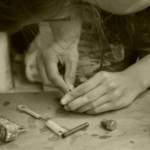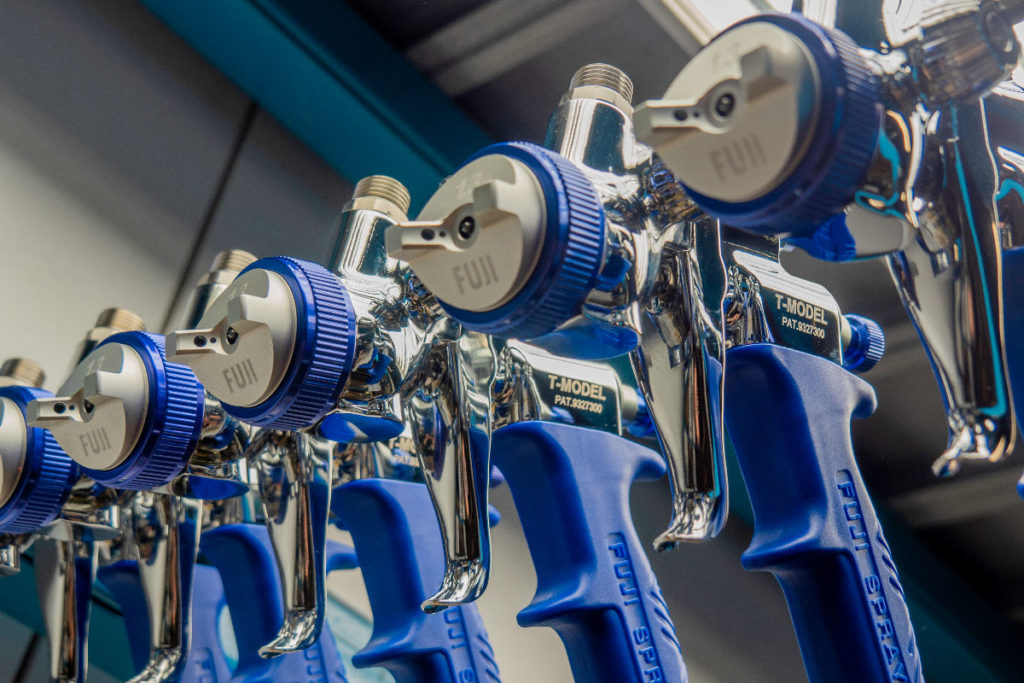A hand or power tool is an investment that can last many years when properly maintained.
I assume caring for your tools is a ritual you follow, but what about your spray equipment?
This seems to be a stumbling block for some folks, because over the past 35 years of crawling through finishing shops, I have come across some really mangy looking spray guns.
And that’s a shame, because a poorly maintained spray gun can cause all sorts of finishing problems, despite the best sanding, the best coatings (such as Emtech!) and the best application technique.
Let’s talk about the basics of spray gun maintenance when using water based finishes and how you can avoid problems.
Here’s a quick checklist of do’s and don’ts to ensure your spray gun isn’t the culprit…
1. Flush your equipment with water and alcohol at the end of each finishing session or production day. Do not hang your gun, still loaded with finish, on the hook overnight (or over the weekend!) and expect it to perform well the next time you pull the trigger. Flushing the fluid passage, cup or tank assembly clear of acrylic or urethane finishes will prevent the clogging of the passages and tip set.
2. Remove the air cap and clean it under running water with a fine-tooth brush. Make sure all the atomization ports (the small holes found on the air cap) are free and clear of dried finish. If these ports are clogged, you will get a split fan pattern and your finish will not atomize properly. If you get tiger-striping or highs/lows in your wet film, it is due to a split fan pattern.

3. Check your trigger assembly to ensure the needle set is sliding in the packing nut and spring center. A sticky needle will not allow the coating to start/stop when you need it to. And speaking of needles, make certain the needle tip is straight. I have seen many bent and damaged needle tips – which results if the needle not seating in the nozzle set, causing poor fluid flow.
4. Check your fluid and air flow control knobs. Ensure that they are not sticky or have stripped threads. These controls must work properly to ensure a correct fan pattern and fluid volume.
5. If you are using a compressed air spray gun, ensure the mini air regulator at the handle of the gun (you ARE using one, right?) is working properly. Ensure the protective glass or plastic covering on the face of the gauge is clear of any over-spray. To this day, I have yet to figure out how finishers forget to care for their air regulators – I worship mine!
6. Last but not least, check the seals on your fluid cup assembly or pressure pot. These seals ensure the vessel will hold the correct amount of fluid and pressure – leaks are common when the seals are broken or ill-fitted.
If you’re using a quality spray system, and you’re maintaining the gun as explained above, there’s a good chance you can eliminate your spray setup as a possible cause of any finishing problems you’re having.
And as we all know about troubleshooting, eliminating possible problems gets you one step closer to the solution.
What’s your take on this? Any other spray gun maintenance / operation tips you’d recommend? Please share your thoughts or read what others are saying in the comments section below.


I have just been using water and Dawn soap to clean my gun after using it. It sounds like you are suggesting mixing alcohol with water for cleaning and if so I assume that is just for water based finishes ?
Myrl – It is OK to use a grease-cutting detergent if you are cleaning out a high oil-content finish, but you MUST follow up with water and alcohol if you are going to proceed with a water based finish thereafter.
-JW-
After each use I completely break down my gun (which happens to be a Fuji) and wash each component with water or other appropriate solvent based what the manufacturer recommends for thinning. I also wash each component in dishwasher detergent with a tooth brush as you suggest. Fuji included a cleaning kit in my purchase that has a variety of different sized brushes for cleaning. I don’t use these after each application but I do use them after each project. I then reassemble my gun and flush it out with mineral spirits, not alcohol as you suggest. This has worked well for me for many years. I’ve also read articles suggesting ammonia but I’ve found that just too uncomfortable to use. Do you feel I should use alcohol rather than mineral spirits? I’ve been pretty much following the maintenance steps you outline above and my gun is as good as new! It only takes 15 minutes to clean the gun after each use to keep it in optimal condition! Thanks for sharing this article and reaffirming my process.
Richard – I greatly appreciate your post, thank you! Mineral spirits will leave an oily residue in the fluid passages that will create a conflict with most water based finishes, therefore I strongly suggest that you DO NOT use mineral spirits. If you need to use a hot solvent to clear the fluid passages I recommend acetone. If the cleaning procedure is based on routine maintenance I suggest that you change over to a 50?50 mix of denatures alcohol and water. If you cannot find denatured alcohol you can use isopropyl alcohol or a neutral pH hard surface cleaner followed with clear water.
-JW-
I spray guitars, usually 3 times a day, and flush after every application. My air cap and fluid nozzle are both removed and live in DNA between coats. I also lube all external moving parts with spray gun lube once a day, and wipe the gun down with DNA between coats. I have guitars finished with Target many years ago, that still look like new. Absolutely the best waterborne finish on the market. I use a Qualspray AM-5008 gravity LVLP, and EM6000 sprays beautifully un-thinned, with minimal overspray. Thanks, Jeff.
Steve – Thank you for your reply…your comments and observations are greatly appreciated. Much obliged.
-JW –
I’d love it if you offered a training class on spray finishing! Nothing like some hands on training.
James – Once we get over the COVID hump you may get your wish. :)
-JW –
The best thing I ever purchased for spray finishing was an ultrasonic cleaner. It has saved me hours of troubleshooting.
Jeff – Thank you for your reply. Can you share more information with us about the ultrasonic machine you are referring to?
-JW-
I only use my gun for spraying Emtech on gun stocks. The instructions that came with my gun, a Finex 1000 HVLP detail gun, said to clean the gun with whatever is used to thin the finish. Since this is a water borne finish, I have been using warm water and Ivory dish soap, followed by a thorough rinsing with warm water. This has worked well for me; is there any reason why I should add alcohol to the mix? Seems like that might speed deterioration of the o-rings and seals, and the soap and water works well. Unless there is some hidden risk/benefit that I’m not seeing, I’m inclined to keep doing what I’m doing.
Tom — Thank you for sharing your procedures with us. If you are happy the end-results of using a mild soap/water blend than this is OK with us. Just ensure that you rinse any soap residue out of the passages and cup.
-JW-
Jeff,
I’m going on 10 years using EM-6000 on my guitar finishing, and very happy with long term performance. I had used several Harbor Freight 6 oz jamb guns, which performed great for clear finish but poorly for sun bursting, I’ve since switch to the Qualspray AM-5008 and smaller AM-8008 gravity LVLP with EM6000 nearly 2 years ago.
On production gun, I successfully keep the cup filled during single day of spraying. My lessons learned is to clean the air cap after each or every other spray session. The 2nd lesson is that the cup must be cleaned each day, I’ve collected thickened lacquer not obvious that later clogged nozzle if only rinsed and brushed on the gun.
Disassembling and Cleaning complete daily is imperative. Thanks for great product and guidelines!
Peter – Thank you for sharing your observations with us!
-JW-
I find that, even with a thorough soapy water cleaning and water rinse, if I put the air cap and nozzle in a jar of alcohol (or acetone) for a few hours the solvent become cloudy with finish that was left behind by the soapy water. So a final rinse of 50/50 DNA/water seems necessary to me.
I’ve had success with a Fuji spray setup (with 3M disposable liners that remind me of Playtex baby bottle liners where you pre-burp out the air) using EM1000 and WVX on mahogany furniture, EM1000 and EM6000 on ash/maple guitars, EM6500 tinted to match paint work for built-in bookcases (remember books?) and even a walnut rifle stock (where the WVX is holding up nicely).
Bob – Great to her from you! Please feel free to chime-in on future posts – your advise is appreciated.
-JeffW-
Jeff, great info here. I use a Fuji G-Xcp gun and Mini Mite 3 HVLP turbine. I rinse with hot water after each spraying session, but after reading your comments here I think I will switch to 50/50 DNA and water. Can you comment on the proper way to dispose of the solution. Is it safe to dump down the drain or do I need to hazmat it?
I’m a hobbyist woodworker trying to up my finishing game and your products have definitely helped. Thanks.
Mike Johnson
Mike – Thank you for your question. Water and alcohol blends can be disposed of directly into your sink drain. Run clear water down the drain after you dispose of the blend to further dilute it.
-JW-